Ergonomic Optimization of University Dormitory Furniture: A Digital Human Modeling Approach Using Jack Software
Abstract
1. Introduction
2. Materials and Methods
3. Results
3.1. Simulation Results of the Original Scheme
3.1.1. Comfort Analysis
3.1.2. Posture Load Risk Assessment
3.1.3. Reachability Verification
3.2. Simulation Results of the Optimized Scheme
3.2.1. Comfort Analysis
3.2.2. Posture Load Risk Assessment
3.2.3. Reachability Verification
4. Discussion
4.1. Analysis of Gender Differences in Comfort
4.2. Health and Educational Value
4.3. Universal Design Concept
4.4. Sustainable Design and Environmental Development
4.5. Limitations and Future Research
5. Conclusions
- (1)
- Traditional dormitory furniture design has the limitation of requiring users to adapt to preset features. The current dormitory furniture lacks adaptability, particularly impacting shorter female users in terms of comfort and reachability.
- (2)
- This study proposes an optimized design featuring adjustable desktop and chair heights that significantly improves comfort and balance for users of varying body types. The addition of a track-based adjustable bookshelf further meets individualized needs, especially enhancing accessibility for shorter users. For female users with a height of about 150 cm, the comfort of the hip and knee joints increased by 14.3% and 51.9%, respectively.
- (3)
- The optimized scheme increases the consideration of the use of diversified groups such as left-handed, blind, and upper-limb disabled people, provides students with a more inclusive and fair learning environment, and further promotes educational equity.
- (4)
- By enhancing the desk design, we achieved a roughly 55.8% reduction in artificial board usage versus the original model, which translates to a significant cut of about 135 kg CO2 e in the GHG footprint. This improvement is crucial for advancing environmental sustainability.
Author Contributions
Funding
Institutional Review Board Statement
Informed Consent Statement
Data Availability Statement
Conflicts of Interest
References
- Kibret, S.; Teshome, D.; Fenta, E.; Hunie, M.; Taye, M.G.; Fentie, Y.; Tamire, T. Medical and Health Science Students’ Perception Towards a Problem-Based Learning Method: A Case of Debre Tabor University. AMEP 2021, 12, 781–786. [Google Scholar] [CrossRef] [PubMed]
- Kuys, J.; Al Mahmud, A.; Kuys, B. A Case Study of University–Industry Collaboration for Sustainable Furniture Design. Sustainability 2021, 13, 10915. [Google Scholar] [CrossRef]
- David, G.C. Ergonomic Methods for Assessing Exposure to Risk Factors for Work-Related Musculoskeletal Disorders. Occup. 2005, 55, 190–199. [Google Scholar] [CrossRef]
- Wang, Z.; Wu, Y.; Jia, Z.; Gao, Q.; Gu, Z. Research on Health and Thermal Comfort of Unit-Type Student Apartments in the Western China Science and Technology Innovation Harbor. Front. Public Health 2022, 10, 850107. [Google Scholar] [CrossRef]
- Wang, H. Research on Design Innovation of Dormitory Furniture in Colleges and Universities. In Proceedings of the 4th International Conference on Education, Management, Arts, Economics and Social Science (ICEMAESS 2017), Sanya, China, 11–12 November 2017; Atlantis Press: Sanya, China, 2017. [Google Scholar]
- Yang, T.; Wang, D. Research on the Design of Indoor Facilities in University Dormitories Based on POE Theory. In Atlantis Highlights in Social Sciences, Education and Humanities, Proceedings of the 2023 2nd International Conference on Educational Innovation and Multimedia Technology (EIMT 2023), Nanchang, China, 17–19 March 2022; Peng, C.F., Asmawi, A., Zhao, C., Eds.; Atlantis Press International BV: Dordrecht, The Netherlands, 2023; Volume 8, pp. 1141–1150. ISBN 978-94-6463-191-3. [Google Scholar]
- Yu, G.; Dai, C.; Huang, S.; Gan, L.; Gao, W. Research on Innovative Application of Modular Design in University Student Apartment Furniture. IOP Conf. Ser. Mater. Sci. Eng. 2019, 573, 012016. [Google Scholar] [CrossRef]
- Kim, M.-K.; Kim, E.-J. The Analysis of Classified Types of Furniture Design for Better Development in University Dormitory Units. Korean Inst. Inter. Des. J. 2015, 24, 169–177. [Google Scholar]
- Cao, Y.; Zhou, T.; Gao, J. Heterogeneous Peer Effects of College Roommates on Academic Performance. Nat. Commun. 2024, 15, 4785. [Google Scholar] [CrossRef]
- Karimi, H.; Adibhesami, M.A.; Ghasemi, M.; Sepehri, B.; Mahdavi Estalkhsar, B. Investigating the Impact of Indoor Environmental Quality and Internal Design on Students’ Satisfaction in Tehran and North Cyprus Dormitories. Int. J. Build. Pathol. Adapt. 2023; ahead-of-print. [Google Scholar] [CrossRef]
- Oguntibeju, O.; Owonuwa, D.; Odunaiya, N. Ergonomic Suitability of Educational Furniture and Possible Health Implications in a University Setting. Adv. Med. Educ. Pract. 2014, 5, 1. [Google Scholar] [CrossRef]
- Fan, C.; Liu, S. Exploring the Associations among Perceived Teacher Emotional Support, Resilience, COVID-19 Anxiety, and Mental Well-Being: Evidence from Chinese Vocational College Students. Curr. Psychol. 2024, 43, 14944–14954. [Google Scholar] [CrossRef]
- Podrekar Loredan, N.; Kastelic, K.; Burnard, M.D.; Šarabon, N. Ergonomic Evaluation of School Furniture in Slovenia: From Primary School to University. Work 2022, 73, 229–245. [Google Scholar] [CrossRef] [PubMed]
- Brink, Y.; Louw, Q.; Grimmer, K. The amount of postural change experienced by adolescent computer users developing seated–related upper quadrant musculoskeletal pain. J. Bodyw. Mov. Ther. 2018, 22, 608–617. [Google Scholar] [CrossRef]
- Kwon, M.-S.; Lee, S.-H.; Cho, I.-R.; Won, Y.-M.; Han, M.-K.; Jung, K.-N.; Lee, J.-H.; Chin, J.-H.; Rho, J.-H.; Kim, J.-Y.; et al. Electromyography Comparison of Normal Chair-Desk System and Assistant Chair-Desk System on Fatigue. J. Phys. Ther. Sci. 2015, 27, 3171–3175. [Google Scholar] [CrossRef] [PubMed]
- Kahya, E. Mismatch between classroom furniture and anthropometric measures of university students. Int. J. Ind. Ergon. 2019, 74, 102864. [Google Scholar] [CrossRef]
- Saha, A.K.; Jahin, M.A.; Rafiquzzaman, M.; Mridha, M.F. Ergonomic Design of Computer Laboratory Furniture: Mismatch Analysis Utilizing Anthropometric Data of University Students. Heliyon 2024, 10, e34063. [Google Scholar] [CrossRef]
- Mokarami, H.; Ansari, S.; Cousins, R.; Varmazyar, S. Assessing the ergonomic status of commonly used chairs in Iran’s universities based on combinational equations and anthropometric indices. Work 2022, 71, 1087–1095. [Google Scholar] [CrossRef]
- Tsao, L.; Ma, L. Using Subject-Specific Three-Dimensional (3D) Anthropometry Data in Digital Human Modelling: Case Study in Hand Motion Simulation. Ergonomics 2016, 59, 1526–1539. [Google Scholar] [CrossRef]
- Schall, M.C., Jr.; Fethke, N.B.; Roemig, V. Digital Human Modeling in the Occupational Safety and Health Process: An Application in Manufacturing. IISE Trans. Occup. Ergon. Hum. Factors 2018, 6, 64–75. [Google Scholar] [CrossRef]
- Kumar, R.; Kalra, P. Ergonomics Evaluation of Lawn Mower Operator’s Working Posture Using JACK Software and Kinect Interface. Work 2022, 72, 497–510. [Google Scholar] [CrossRef]
- Zhang, Y.; Wu, X.; Gao, J.; Chen, J.; Xv, X. Simulation and Ergonomic Evaluation of Welders’ Standing Posture Using Jack Software. Int. J. Environ. Res. Public Health 2019, 16, 4354. [Google Scholar] [CrossRef]
- Ji, X.; Piovesan, D.; Arenas, M.; Liu, H. Analysis of Healthcare Push and Pull Task via JACK: Predicted Joint Accuracy during Full-Body Simulation. Appl. Sci. 2022, 12, 6450. [Google Scholar] [CrossRef]
- Mao, W.; Yang, X.; Wang, C.; Hu, Y.; Gao, T. A Physical Fatigue Evaluation Method for Automotive Manual Assembly: An Experiment of Cerebral Oxygenation with ARE Platform. Sensors 2023, 23, 9410. [Google Scholar] [CrossRef] [PubMed]
- GB/T 10000-2023; Human Dimensions of Chinese Adults. Standardization Administration of the People’s Republic of China: Shanghai, China, 2023.
- Qi, M.; Gao, Y.; Zhao, X.; Jones, C.; Moyle, W.; Shen, S.; Li, P. Development and Validity of a Mentally-Passive and Mentally-Active Sedentary Time Questionnaire in Nursing College Students. Front. Public Health 2023, 11, 1180853. [Google Scholar] [CrossRef]
- Castro, O.; Vergeer, I.; Bennie, J.; Biddle, S.J.H. Feasibility of Reducing and Breaking Up University Students’ Sedentary Behaviour: Pilot Trial and Process Evaluation. Front. Psychol. 2021, 12, 661994. [Google Scholar] [CrossRef] [PubMed]
- Claidière, N.; Bowler, M.; Whiten, A. Evidence for Weak or Linear Conformity but Not for Hyper-Conformity in an Everyday Social Learning Context. PLoS ONE 2012, 7, e30970. [Google Scholar] [CrossRef]
- Toh, S.H.; Coenen, P.; Howie, E.K.; Straker, L.M. The Associations of Mobile Touch Screen Device Use with Musculoskeletal Symptoms and Exposures: A Systematic Review. PLoS ONE 2017, 12, e0181220. [Google Scholar] [CrossRef]
- Hillesund, T.; Schilhab, T.; Mangen, A. Text Materialities, Affordances, and the Embodied Turn in the Study of Reading. Front. Psychol. 2022, 13, 827058. [Google Scholar] [CrossRef]
- Wan, Q.; Zhao, H.; Li, J.; Xu, P. Hip positioning and sitting posture recognition based on human sitting pressure image. Sensors 2021, 21, 426. [Google Scholar] [CrossRef]
- Lu, C.; Chen, Z.; Li, Y.; Fu, X.; Tang, Y. Hole Matrix Mapping Model for Partitioned Sitting Surface Based on Human Body Pressure Distribution Matrix. Healthcare 2023, 11, 895. [Google Scholar] [CrossRef]
- BS EN 1729-1:2015; Furniture-Chairs and Tables for Educational Institutions—Part 1: Functional Dimensions. The British Standards Institution: London, UK, 2015.
- Farooq, M.S.; Shafi, I.; Khan, H.; Díez, I.D.L.T.; Breñosa, J.; Espinosa, J.C.M.; Ashraf, I. IoT enabled intelligent stick for visually impaired people for obstacle recognition. Sensors 2022, 22, 8914. [Google Scholar] [CrossRef]
- Chang, I.; Castillo, J.; Montes, H. Technology-based social innovation: Smart city inclusive system for hearing impairment and visual disability citizens. Sensors 2022, 22, 848. [Google Scholar] [CrossRef] [PubMed]
- Porter, J.M.; Gyi, D.E. Exploring the optimum posture for driver comfort. Int. J. Veh. Des. 1998, 19, 255–266. [Google Scholar]
- Zhang, L.; Helander, M.G.; Drury, C.G. Identifying Factors of Comfort and Discomfort in Sitting. Hum Factors 1996, 38, 377–389. [Google Scholar] [CrossRef]
- Janabi-Sharifi, F.; Vakanski, A. Analysis of visual acuity and motion resolvability as measures for optimal visual perception of the workspace. Appl. Ergon. 2011, 42, 473–486. [Google Scholar] [CrossRef] [PubMed]
- Waongenngarm, P.; Rajaratnam, B.S.; Janwantanakul, P. Internal oblique and transversus abdominis muscle fatigue induced by slumped sitting posture after 1 hour of sitting in office workers. Saf. Health Work. 2016, 7, 49–54. [Google Scholar] [CrossRef] [PubMed]
- Liu, W.; Wu, Y. The Design of College Student Apartment Based on Ergonomics. In Proceedings of the 2010 IEEE 17Th International Conference on Industrial Engineering and Engineering Management, Xiamen, China, 29–31 October 2010; IEEE: New York, NY, USA, 2010; pp. 1605–1609. [Google Scholar]
- Gu, M.; Wei, Y.; Pan, H.; Ying, Y. A new real-time pinch detection algorithm based on model reference kalman prediction and srms for electric adjustable desk. Sensors 2020, 20, 4699. [Google Scholar] [CrossRef]
- Bonilla-Lugo, J.I.; Wolf, S.E. A Vision for Physical Chemistry: An Inclusive Future for All Abilities. ACS Phys. Chem. Au 2024, 4, 94–96. [Google Scholar] [CrossRef]
- Lao, W.-L. Greenhouse Gas Footprint Assessment of Wood-Based Panel Production in China. J. Clean. Prod. 2023, 389, 136064. [Google Scholar] [CrossRef]
- Tariq, R.; Mohammed, A.; Alshibani, A.; Ramírez-Montoya, M.S. Complex artificial intelligence models for energy sustainability in educational buildings. Sci. Rep. 2024, 14, 15020. [Google Scholar] [CrossRef]
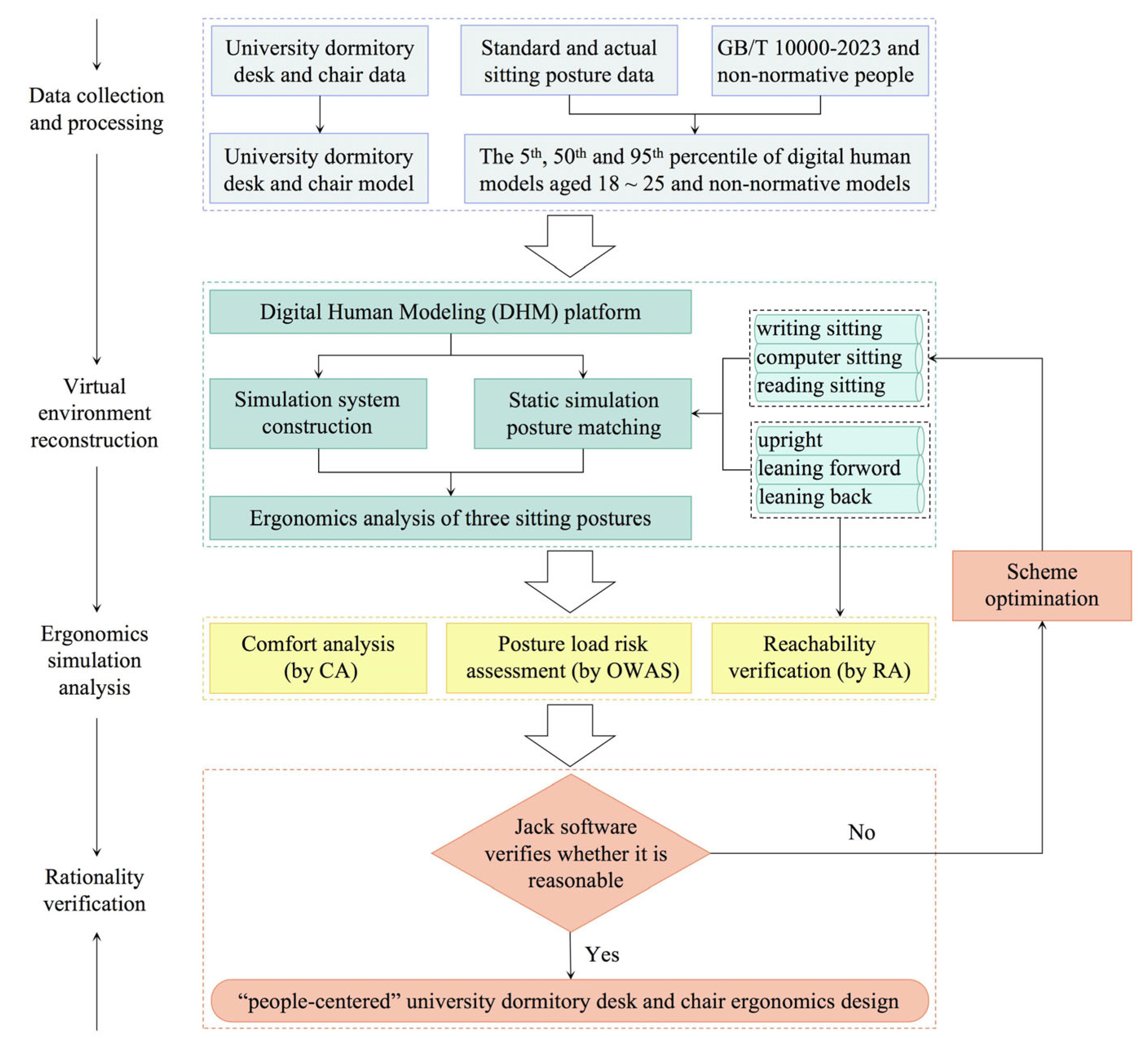
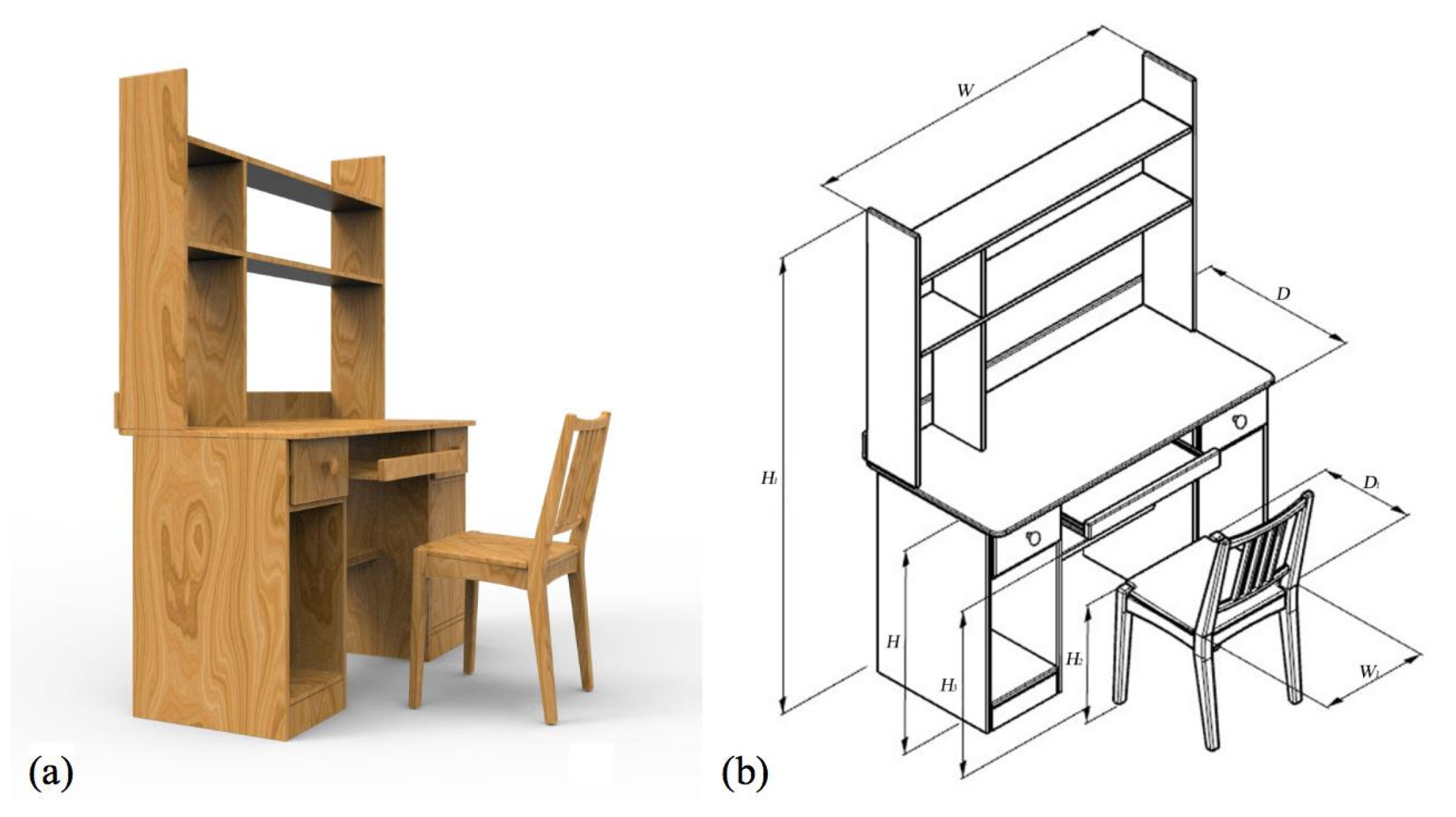
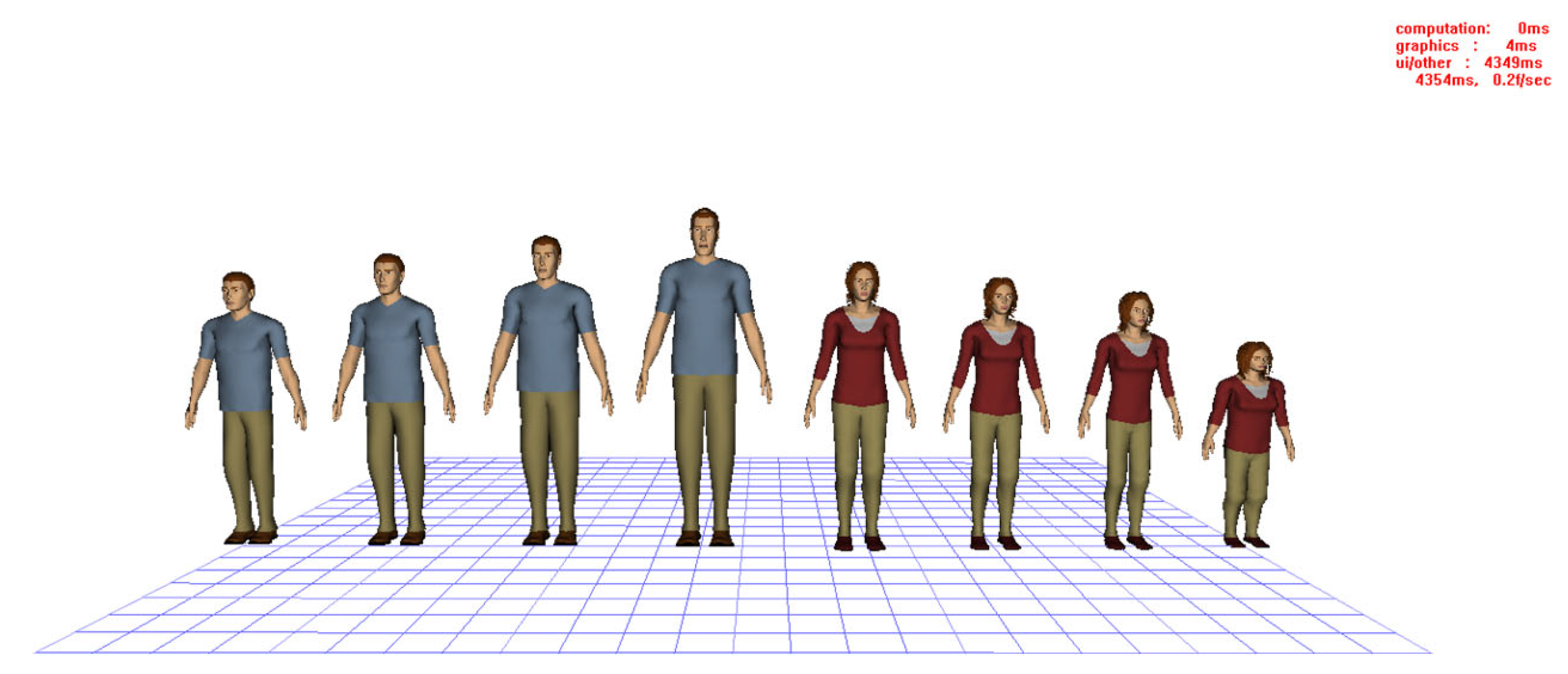
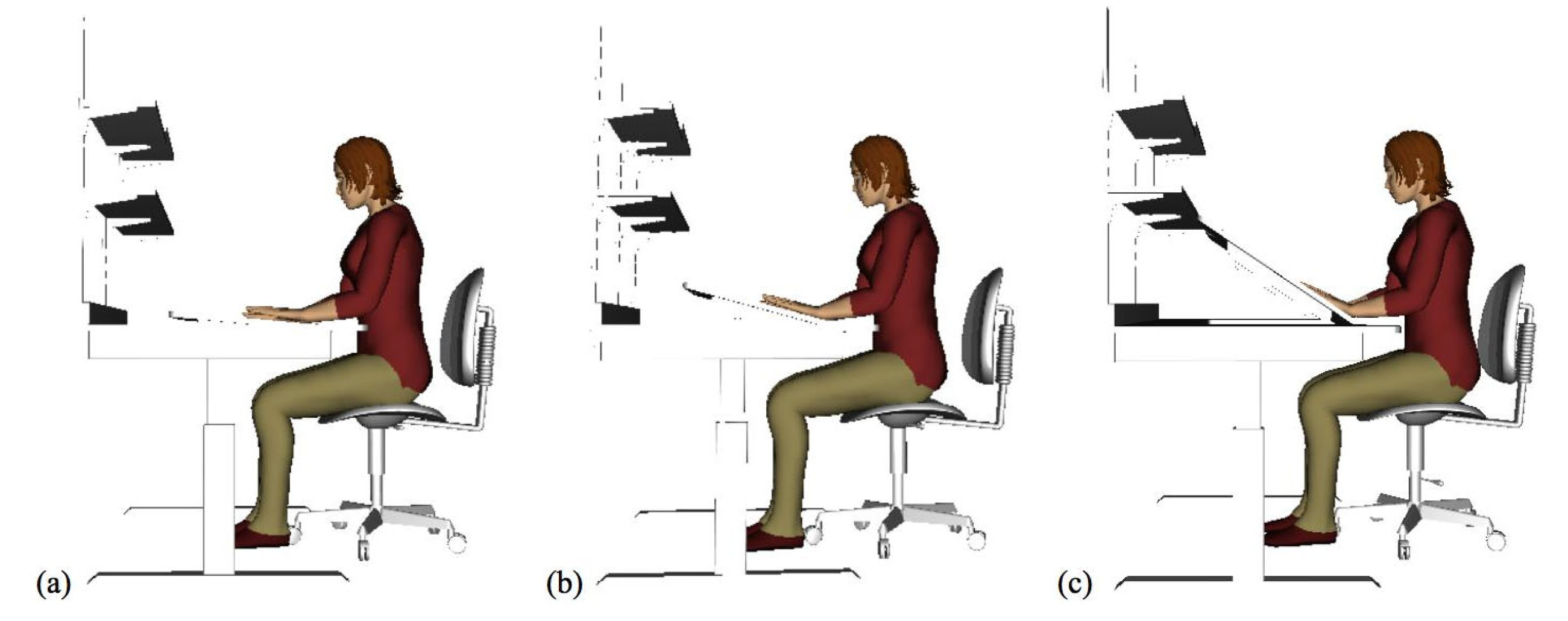

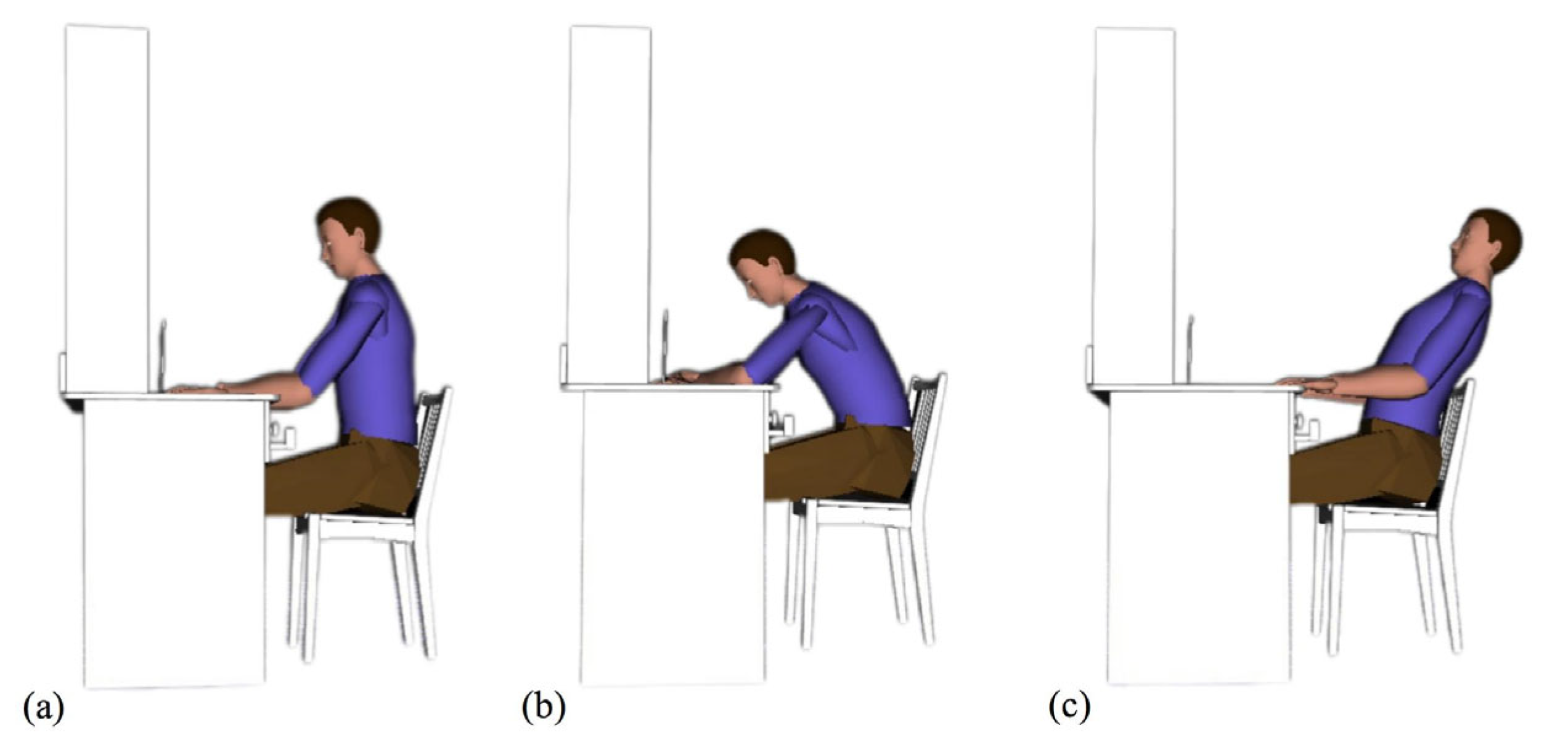
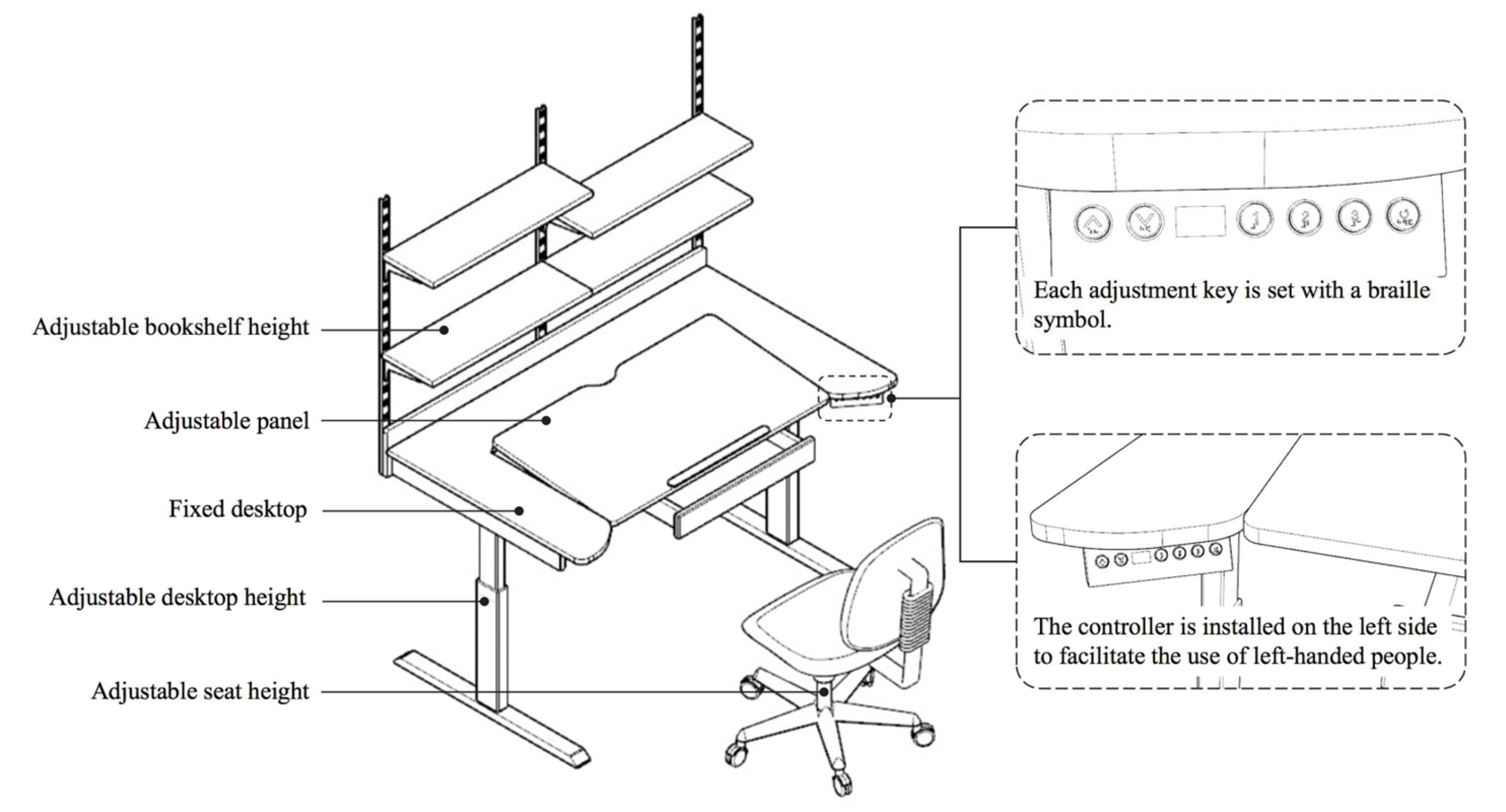
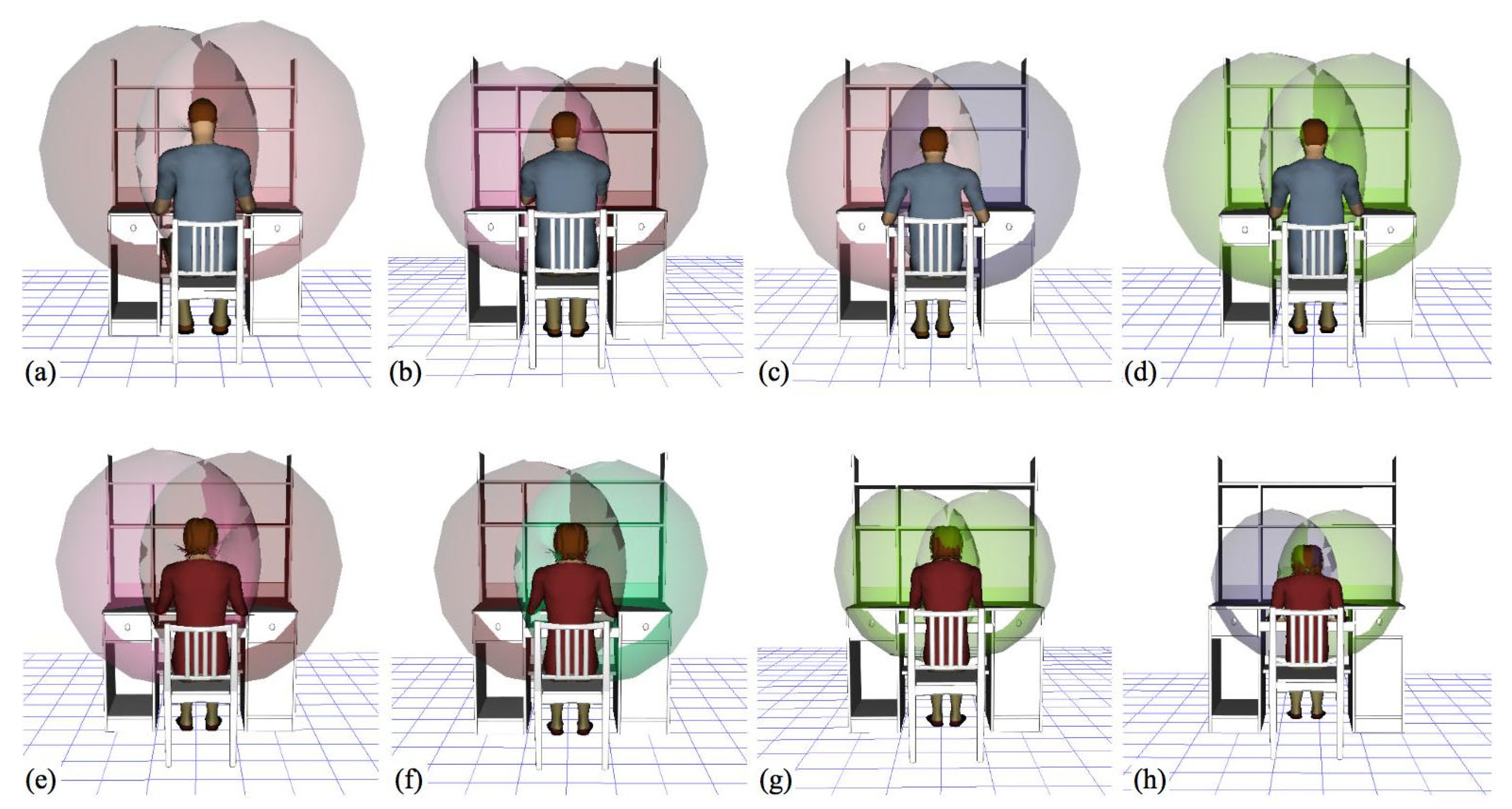
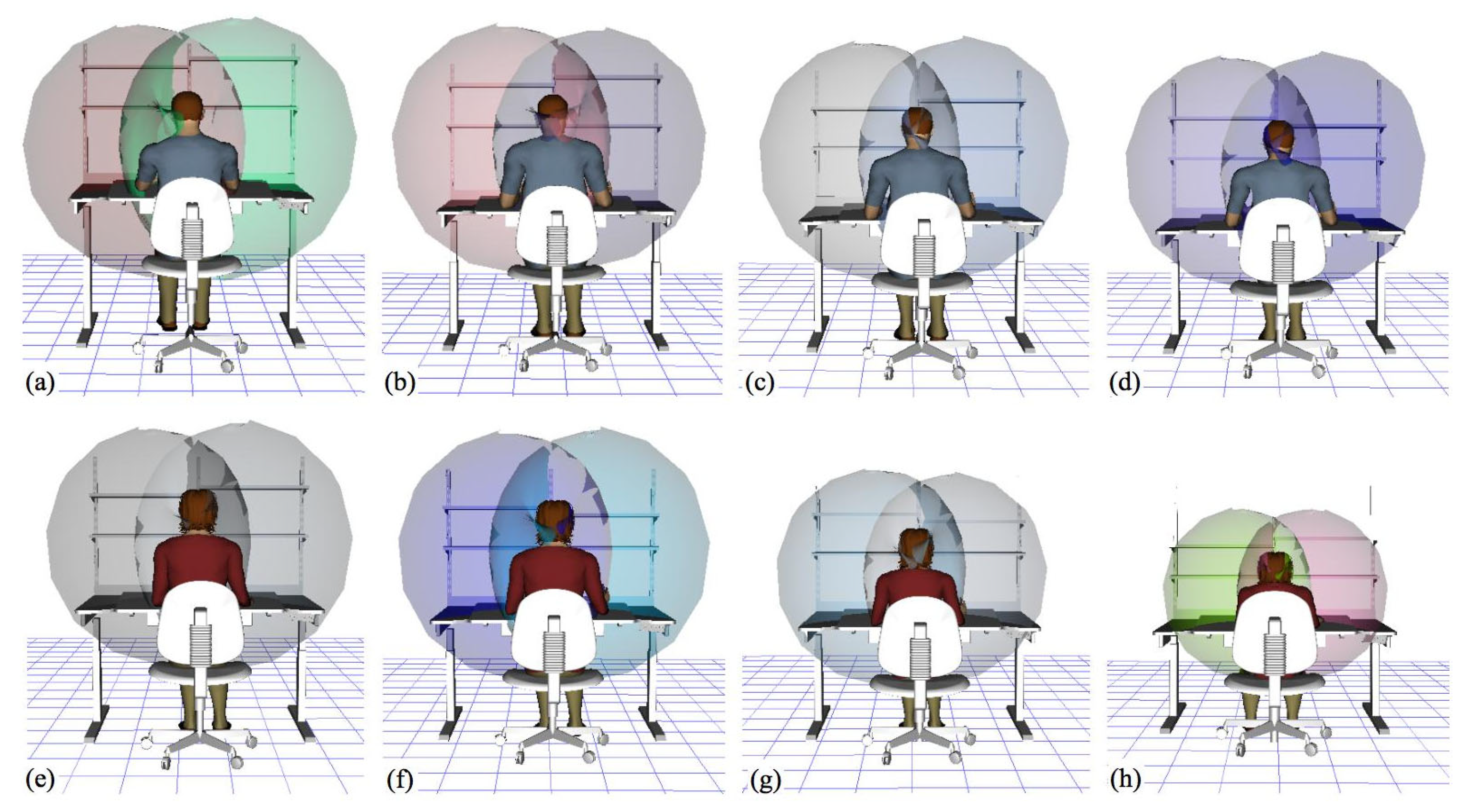

| Symbol | Description | Dimension/mm |
|---|---|---|
| H | Desktop height | 770 |
| H1 | Total height of a desk | 1723 |
| H2 | Seat height | 430 |
| H3 | Table clearance height | 630 |
| W | Desktop width | 1200 |
| W1 | Seat width | 400 |
| D | Desktop depth | 580 |
| D1 | Seat depth | 410 |
| Body Dimension | NM | M95th | M50th | M5th | F95th | F50th | F5th | NF |
|---|---|---|---|---|---|---|---|---|
| Stature/mm | 2000 | 1837 | 1720 | 1616 | 1700 | 1599 | 1512 | 120 |
| Body weight/kg | 101 | 86 | 64 | 50 | 68 | 52 | 42 | 37 |
| Sitting height/mm | 1064 | 994 | 936 | 881 | 933 | 881 | 830 | 671 |
| Sitting shoulder height/mm | 729 | 668 | 614 | 567 | 621 | 574 | 531 | 425 |
| Sitting knee height/mm | 608 | 558 | 511 | 471 | 520 | 478 | 439 | 364 |
| Sitting popliteal height/mm | 508 | 461 | 422 | 385 | 427 | 389 | 357 | 315 |
| Sitting hip-knee distance/mm | 711 | 624 | 573 | 530 | 592 | 547 | 508 | 423 |
| Main Dimension/mm | BS EN 1729-1:2015 | Improved Scheme |
|---|---|---|
| Desktop width | 600 (min) | 1300 |
| Desktop depth | 500 (min) | 600 |
| Desktop height | 460~820 (±20) | 440~840 |
| Seat width | 240~400 (min) | 420 |
| Seat depth | 300~460 (±15) | 430 |
| Seat height | 260~510 (±10) | 250~520 |
| Main Dimension/mm | NM | M95th | M50th | M5th | F95th | F50th | F5th | NF |
|---|---|---|---|---|---|---|---|---|
| Desktop height | 830 | 780 | 730 | 670 | 730 | 660 | 640 | 550 |
| Chair height | 510 | 450 | 440 | 390 | 440 | 390 | 360 | 320 |
| Upper shelf height | 1700 | 1540 | 1540 | 1400 | 1540 | 1400 | 1400 | 1100 |
| Angle | Gender | Upright Sitting | Leaning Forward Sitting | Leaning Back Sitting | |||||||||
|---|---|---|---|---|---|---|---|---|---|---|---|---|---|
| 5th | 50th | 95th | N | 5th | 50th | 95th | N | 5th | 50th | 95th | N | ||
| Head flexion | M | 22.1 | 22.1 | 5.6 | 25.0 | 13.4 | 13.5 | 14.3 | 13.9 | 33.2 | 33.0 | 27.2 | 32.4 |
| F | 2.9 | 21.6 | 22.3 | 21.6 | 0.7 | 15.8 | 13.9 | 13.5 | 17.1 | 32.0 | 34.8 | 32.0 | |
| Upper arm flexion right | M | 30.6 | 30.6 | 44.6 | 27.5 | 36.7 | 36.7 | 37.9 | 33.9 | 38.0 | 32.3 | 38.3 | 33.9 |
| F | 62.7 | 29.0 | 29.0 | 12.7 | 48.2 | 28.0 | 35.3 | 37.0 | 36.9 | 33.2 | 26.7 | 42.9 | |
| Upper arm flexion left | M | 30.2 | 30.2 | 45.4 | 27.3 | 40.7 | 47.5 | 45.1 | 37.7 | 42.3 | 28.2 | 42.6 | 32.2 |
| F | 50.3 | 34.8 | 35.5 | 18.0 | 36.4 | 45.4 | 40.9 | 49.8 | 37.5 | 31.7 | 26.3 | 40.0 | |
| Elbow included right | M | 132.9 | 132.9 | 120.9 | 137.4 | 102.0 | 104.9 | 124.0 | 118.6 | 161.5 | 148.1 | 173.9 | 163.7 |
| F | 128.0 | 130.3 | 131.5 | 124.8 | 97.9 | 91.9 | 112.9 | 105.4 | 161.1 | 148.9 | 144.4 | 177.2 | |
| Elbow included left | M | 126.5 | 126.5 | 120.4 | 131.9 | 104.6 | 107.6 | 123.8 | 115.0 | 158.8 | 148.6 | 174.3 | 166.2 |
| F | 89.4 | 138.7 | 143.6 | 130.6 | 69.9 | 91.9 | 114.9 | 112.8 | 160.9 | 156.1 | 155.3 | 177.2 | |
| Trunk thigh right | M | 102.2 | 102.2 | 91.2 | 93.4 | 82.6 | 88.9 | 88.3 | 79.4 | 119.6 | 126.3 | 115.1 | 108.7 |
| F | 88.7 | 110.3 | 106.0 | 119.3 | 83.4 | 91.9 | 93.8 | 95.6 | 123.5 | 125.0 | 122.5 | 127.3 | |
| Trunk thigh left | M | 102.2 | 102.2 | 90.7 | 92.4 | 81.8 | 88.9 | 88.1 | 79.7 | 120.4 | 125.6 | 114.8 | 109.5 |
| F | 88.2 | 110.3 | 106.0 | 119.3 | 82.9 | 95.6 | 94.1 | 95.9 | 120.4 | 125.9 | 123.6 | 126.2 | |
| Knee included right | M | 109.6 | 109.6 | 109.0 | 89.9 | 103.9 | 109.6 | 106.4 | 99.3 | 102.9 | 112.2 | 102.4 | 93.6 |
| F | 98.4 | 120.1 | 114.4 | 118.1 | 97.9 | 112.8 | 110.5 | 112.8 | 102.5 | 109.4 | 109.2 | 109.0 | |
| Knee included left | M | 109.6 | 109.6 | 108.4 | 87.1 | 103.0 | 109.6 | 105.8 | 99.4 | 103.9 | 109.9 | 101.7 | 92.5 |
| F | 97.3 | 120.1 | 114.4 | 118.1 | 96.8 | 112.5 | 110.3 | 112.5 | 98.6 | 110.5 | 110.6 | 106.9 | |
| Foot calf included right | M | 97.6 | 97.6 | 90.5 | 85.4 | 96.5 | 97.6 | 99.9 | 96.4 | 92.0 | 93.0 | 88.9 | 92.0 |
| F | 82.5 | 100.0 | 98.6 | 89.1 | 80.2 | 96.7 | 96.1 | 96.7 | 82.6 | 93.2 | 93.1 | 91.5 | |
| Foot calf included left | M | 97.6 | 97.6 | 95.1 | 90.0 | 96.8 | 97.6 | 99.3 | 96.0 | 92.1 | 92.9 | 88.4 | 91.0 |
| F | 86.8 | 100.0 | 98.6 | 89.1 | 84.5 | 94.4 | 93.9 | 94.4 | 86.7 | 93.4 | 93.3 | 91.2 | |
| Angle | Gender | Writing Sitting | Computer Sitting | Reading Sitting | |||||||||
|---|---|---|---|---|---|---|---|---|---|---|---|---|---|
| 5th | 50th | 95th | N | 5th | 50th | 95th | N | 5th | 50th | 95th | N | ||
| Head flexion | M | 21.9 | 21.7 | 5.6 | 14.7 | 21.4 | 19.7 | 3.2 | 19.6 | 19.1 | 5.9 | 5.6 | 8.1 |
| F | 11.4 | 16.0 | 20.5 | 13.7 | 12.9 | 20.4 | 21.3 | 13.7 | 6.8 | 10.3 | 12.5 | 13.9 | |
| Upper arm flexion right | M | 30.5 | 23.4 | 40.0 | 32.2 | 22.7 | 36.8 | 31.1 | 21.1 | 23.7 | 35.8 | 44.6 | 26.2 |
| F | 37.1 | 28.8 | 29.2 | 20.5 | 39.1 | 28.5 | 22.1 | 25.3 | 50.0 | 31.0 | 43.5 | 28.4 | |
| Upper arm flexion left | M | 34.2 | 27.6 | 40.9 | 33.7 | 31.5 | 37.7 | 42.2 | 22.9 | 35.0 | 40.2 | 45.4 | 24.8 |
| F | 50.4 | 34.6 | 29.5 | 22.4 | 46.3 | 34.1 | 26.6 | 31.0 | 56.7 | 36.0 | 49.9 | 41.3 | |
| Elbow included right | M | 131.1 | 111.2 | 114.2 | 112.9 | 113.9 | 136.2 | 116.7 | 92.5 | 100.2 | 97.4 | 120.9 | 87.1 |
| F | 113.2 | 128.9 | 125.5 | 124.5 | 118.7 | 125.3 | 110.4 | 120.6 | 114.3 | 108.1 | 114.0 | 102.9 | |
| Elbow included left | M | 132.2 | 108.9 | 113.7 | 109.8 | 118.3 | 127.8 | 134.5 | 90.7 | 107.5 | 101.4 | 120.4 | 89.9 |
| F | 122.4 | 133.0 | 116.8 | 127.4 | 129.2 | 128.5 | 109.1 | 133.0 | 113.2 | 115.4 | 112.6 | 95.5 | |
| Trunk thigh right | M | 96.6 | 98.7 | 91.4 | 102.2 | 97.3 | 101.5 | 90.5 | 107.8 | 95.2 | 98.7 | 91.2 | 107.8 |
| F | 90.1 | 96.2 | 100.8 | 110.3 | 90.1 | 100.7 | 100.9 | 110.9 | 90.1 | 100.7 | 100.9 | 110.9 | |
| Trunk thigh left | M | 96.5 | 98.7 | 90.9 | 102.3 | 96.0 | 101.5 | 90.6 | 107.8 | 93.9 | 98.7 | 90.7 | 107.8 |
| F | 90.2 | 96.3 | 100.8 | 110.3 | 111.1 | 100.8 | 100.9 | 110.9 | 90.9 | 100.8 | 100.9 | 110.9 | |
| Knee included right | M | 106.2 | 108.7 | 106.6 | 109.6 | 107.1 | 108.7 | 100.3 | 107.8 | 104.6 | 108.7 | 109.0 | 107.8 |
| F | 108.9 | 102.6 | 102.8 | 110.0 | 110.0 | 107.8 | 102.8 | 101.7 | 111.1 | 107.8 | 102.8 | 101.7 | |
| Knee included left | M | 106.2 | 108.7 | 105.4 | 109.6 | 105.1 | 108.7 | 101.1 | 107.8 | 102.7 | 108.7 | 108.4 | 107.8 |
| F | 108.7 | 100.1 | 102.8 | 110.0 | 100.3 | 105.3 | 102.8 | 103.0 | 110.0 | 105.3 | 102.8 | 103.0 | |
| Foot calf included right | M | 97.0 | 97.5 | 87.7 | 97.6 | 96.6 | 97.5 | 94.9 | 90.3 | 96.2 | 97.5 | 90.5 | 90.3 |
| F | 104.5 | 96.8 | 92.1 | 89.9 | 109.6 | 97.5 | 92.1 | 80.9 | 109.6 | 97.5 | 92.1 | 80.9 | |
| Foot calf included left | M | 97.0 | 97.4 | 92.0 | 97.6 | 95.1 | 97.4 | 95.5 | 90.3 | 94.8 | 97.4 | 95.1 | 90.3 |
| F | 109.5 | 94.6 | 92.1 | 89.9 | 101.6 | 95.3 | 92.1 | 82.5 | 101.6 | 95.3 | 92.1 | 82.5 | |
Disclaimer/Publisher’s Note: The statements, opinions and data contained in all publications are solely those of the individual author(s) and contributor(s) and not of MDPI and/or the editor(s). MDPI and/or the editor(s) disclaim responsibility for any injury to people or property resulting from any ideas, methods, instructions or products referred to in the content. |
© 2025 by the authors. Licensee MDPI, Basel, Switzerland. This article is an open access article distributed under the terms and conditions of the Creative Commons Attribution (CC BY) license (https://creativecommons.org/licenses/by/4.0/).
Share and Cite
Wei, Y.; Chen, Y. Ergonomic Optimization of University Dormitory Furniture: A Digital Human Modeling Approach Using Jack Software. Sustainability 2025, 17, 299. https://doi.org/10.3390/su17010299
Wei Y, Chen Y. Ergonomic Optimization of University Dormitory Furniture: A Digital Human Modeling Approach Using Jack Software. Sustainability. 2025; 17(1):299. https://doi.org/10.3390/su17010299
Chicago/Turabian StyleWei, Yihan, and Yushu Chen. 2025. "Ergonomic Optimization of University Dormitory Furniture: A Digital Human Modeling Approach Using Jack Software" Sustainability 17, no. 1: 299. https://doi.org/10.3390/su17010299
APA StyleWei, Y., & Chen, Y. (2025). Ergonomic Optimization of University Dormitory Furniture: A Digital Human Modeling Approach Using Jack Software. Sustainability, 17(1), 299. https://doi.org/10.3390/su17010299





